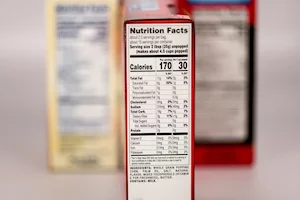The standard American diet can often be missing key nutrients and vitamins for optimal health. Understanding food labels and ingredient lists is vital to smart grocery shopping and better nutrition intake. Whether you’re interested in weight loss or want to know more about how to improve gut health, we have made a helpful guide on how to read food labels and what to look for and avoid at the store!
Overview: How To Read Food Labels
 A Nutrition Facts Label is required by the FDA and is intended to help you see at a glance the following categories: serving size, calories, nutrients, % of daily value, and ingredients list. Here are a few things to keep in mind when looking at a food label:
A Nutrition Facts Label is required by the FDA and is intended to help you see at a glance the following categories: serving size, calories, nutrients, % of daily value, and ingredients list. Here are a few things to keep in mind when looking at a food label:
- Nutrients you should look for and try to eat less of include trans fat, saturated fat, sodium, and added sugars.
- Nutrients you should ensure you’re getting enough of are protein, fiber, Vitamin D, calcium, iron, and potassium.
- Fiber is your friend! It keeps your digestive tract functioning properly and helps you feel fuller longer.
- Be wary of food label claims on the front of the box/packaging– descriptions such as “light”, “multigrain”, and even “low-fat” or “low-carb” can be misleading.
- Other harmful ingredients in packaged foods to watch out for are high fructose corn syrup, enriched flours and grains, which have little nutritional value, as well as processed oils like canola oil, cottonseed oil, grapeseed oil, and sunflower oil, which are highly inflammatory and can contribute to a variety of health concerns.
The Protein-to-Carb Ratio
One of the most important things to know about how to read food labels is the protein-to-carbohydrate ratio. To maintain a healthy weight, you must be aware of how macronutrients, specifically protein and carbs, affect your body. So, when reading food labels, you ideally want the amount of carbohydrates to not be more than double the amount of protein. For example, if you had a label with 30 grams of carbs, then the protein amount should be at least 15 grams.
Good Vs. Bad Forms of Carbs
 But you should also know that not all carbohydrates are bad; in fact, your body needs carbs to function, so limiting them too much can have the opposite effect of what you want. There are two main categories of carbohydrates– simple and complex. Simple carbs are not as healthy, as they are digested quickly, can cause spikes in blood sugar, and don’t keep you full. Complex carbs, on the other hand, are the better form since they are nutrient-dense and typically contain more fiber. Here’s a quick breakdown of some good carbs versus bad ones:
But you should also know that not all carbohydrates are bad; in fact, your body needs carbs to function, so limiting them too much can have the opposite effect of what you want. There are two main categories of carbohydrates– simple and complex. Simple carbs are not as healthy, as they are digested quickly, can cause spikes in blood sugar, and don’t keep you full. Complex carbs, on the other hand, are the better form since they are nutrient-dense and typically contain more fiber. Here’s a quick breakdown of some good carbs versus bad ones:
- GOOD (complex carbs): brown rice and breads, beans, seeds, oats, potatoes, yams, fresh fruits and vegetables
- BAD (simple carbs): white breads and pastas, cakes, cookies, and soda
How To Calculate Net Carbs
If you want to start counting your carbs or just be more mindful of what you’re eating, calculating net carbs is a good place to start. For whole foods like avocado, potatoes, and fruit, the formula is simple: total carbs – fiber = net carbs. Since fiber is not able to be digested by the body, this simple equation determines how much of the carbohydrates you consume are actually ingested and absorbed. For packaged foods, the formula is a little more complicated, because you must include sugar alcohol carbs into the equation, which include isomalt, maltitol, sorbitol, and xylitol. The body processes these sugar alcohols similarly to fiber, and the general rule is that you can subtract half of the sugar alcohol carbs from the total carbs. So this formula looks like this: total carbs – fiber – half the carbs from sugar alcohols = net carbs.
Nutrition & Diet Support at Elite Personalized Medicine
 We hope you found this information helpful about how to read food labels and grocery shop more effectively! At our functional medical clinic, we can provide additional support regarding personalized weight loss programs and nutrition advice. If you’re struggling to form healthy eating habits, want motivational support along your weight loss journey, or need guidance concerning inflammation and gut health, our professional team has the expertise to help you achieve your goals and live a healthier life. Reach out to us today about our holistic health coaching services!
We hope you found this information helpful about how to read food labels and grocery shop more effectively! At our functional medical clinic, we can provide additional support regarding personalized weight loss programs and nutrition advice. If you’re struggling to form healthy eating habits, want motivational support along your weight loss journey, or need guidance concerning inflammation and gut health, our professional team has the expertise to help you achieve your goals and live a healthier life. Reach out to us today about our holistic health coaching services!











